Can Bees See Red?
Do Bees Visit Red Flowers?
Question:
Can bees see red flowers? This questions causes queries and confusion, particularly given that it is reported bees cannot see red, yet bees are indeed seen visiting red flowers. Here is such a query:
Hi
I thought I read somewhere that bees can’t see the color red flowers, but just the other day I absolutely saw a bee on a red flower. If bees can’t see red, why or how did it see or visit the flower? Can bees see red after all? I avoided red flowers in my garden. Thank you.
Paula, USA
The Short Answer is:
Bees cannot distinguish red very well, however, they can detect ultra violet markings in red flowers, and hence are often seen foraging on flowers in shades of red.
Why Bees Can't See The Red Pigment In Flowers
Like humans, bees are trichromatic – that it, they possess 3 independent colour receptors behind each eye lens. However, whereas in humans, these receptors pick up green, red and blue, in bees these receptors are most sensitive to the green, blue and ultra-violet light.
Hence, unlike humans, bees cannot see red or shades of red very well.
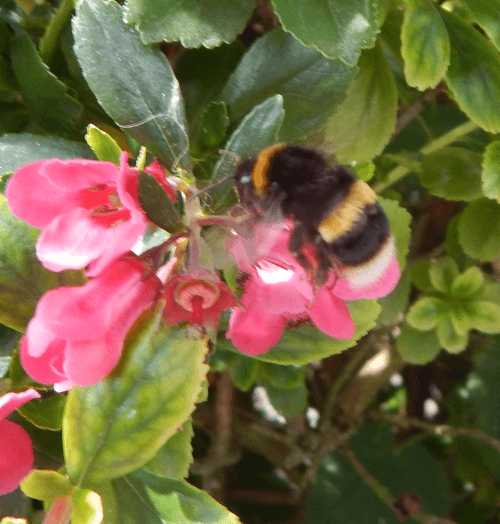 Bumble bee foraging on Escallonia.
Bumble bee foraging on Escallonia.Why bees visit flowers that are red
Whereas humans see only the visible spectrum, and not ultraviolet light, bees pick up ultra violet rays and markings that are invisible to humans.
So, although bees do not distinguish shades of red, they can, however see ultraviolet markings in flowers. These ultraviolet markings or stripes act as landing guides, leading the bee into the nectar and pollen reward offered to the bee by the flower.
Of course, bees are also attracted to flowers because of their scent.
There may be other factors too, which are relevant to whether a bee will visit a flower or not. These could include:
- The age and development of the flower itself.
Even from personal observation I have noted that even when an attractive flower is in bloom, initially it may not be visited, until at some point I see bees all over it. I observe this every year - it's especially obvious with my large patch of beach aster and indeed our manuka bush. Eventually the flowers fade and the bees are no longer interested. - The background colours against which a flower appears.
- The relative attractiveness of other flowers in the area in terms of reward, colour, fragrance.
- The nutritional needs of the bee – for example, bees may switch preference to high pollen producing or high nectar producing flowers depending on the needs of the individual bee and the colony.
- As previously mentioned, the scent of the flower.
What would be interesting to know is how all these factors interplay when bees engage in nectar robbing of red flowers.
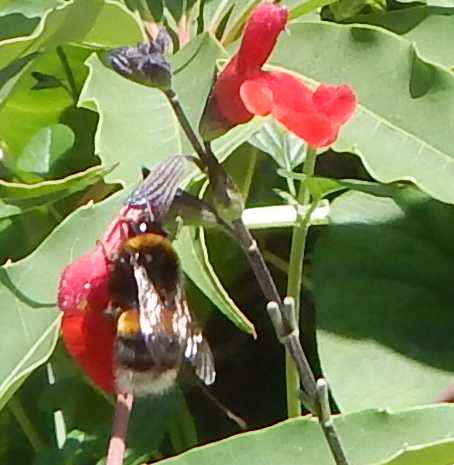 Here we have a bumble bee nectar robbing a red flower a variety of salvia (I'm not sure which).
Here we have a bumble bee nectar robbing a red flower a variety of salvia (I'm not sure which).How do we know what colours /colors bees can see?
This topic has been extensively studied by scientists. One of the most famous is a study from an Austrian scientist called Karl von Frisch in 1956. He set up a number of clever experiments in which he trained honey bees to associate coloured cards with food rewards (a dish of sugar water).
Depending on how a bee saw the coloured card, they may or may get confused – for example, visiting a card that was either the same colour or not, would determine whether or not the bees could distinguish between the colours.
Of course, science moves on and what is proven today may be disproven or added to in years to come.
If bees can see red, which red flowers are visited by bees?
There are certainly a number of flowering plants and shrubs with red flowers that are attractive to bees.
I can't possibly list them all on this site, but here are just a few of them - enough to show you there are options available if you want red flowers for the bees in your garden:
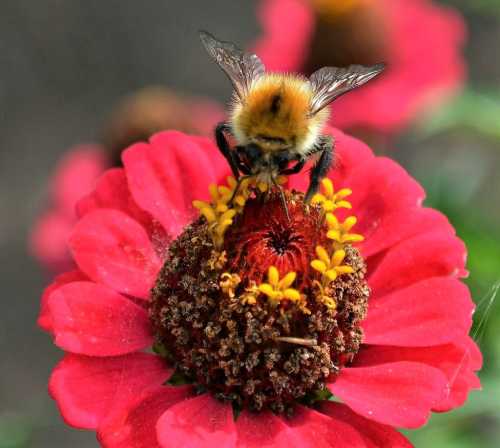
Bumble bee on Zinnia. As far as I'm aware, some of the best Zinnia flowers for bees tend to be part of a 'series' or 'mix' that will include shades of red (as well as pink, yellow and orange). You could try; Zinnia Profusion Series; Zinnia elegans Giant Double Mixed; Zinnia elegans Pulcino Mixed; Zinnia elegans Sprite Mixed or Zinnia elegans Cresto Mixed.
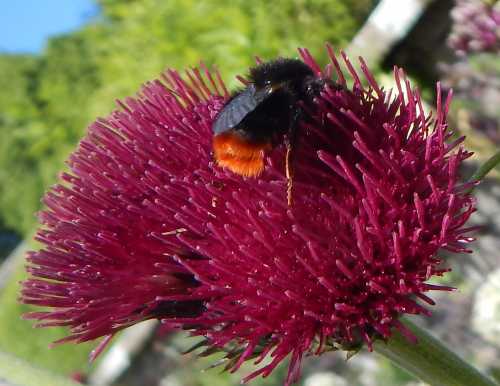
Cirsium rivulare - 'Atropurpureum' is popular with a range of bees and other pollinators. It's a member of the thistles, but is a welcome addition to the garden border.
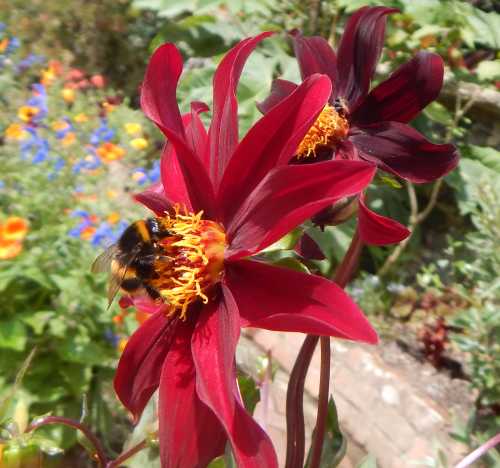
Bees cannot resist the pollen laden anthers in these beautiful deep red dahlias. Red dahlias recommended for bees: 'Bishop of Auckland'; ‘Bishop of Llandaff’; 'Cascade Ken'; 'Pulp Fiction'; 'Hillcrest Regal'; 'Happy Days Red Flame'; 'Dark Desire'; 'Trelyn Crimson'; 'Pat Knight'; 'Dilys Ayling'; 'Bednall Beauty'; 'Tartarus'; 'Freya's Thalia' and 'Starry Eyes - Red'. More are available!
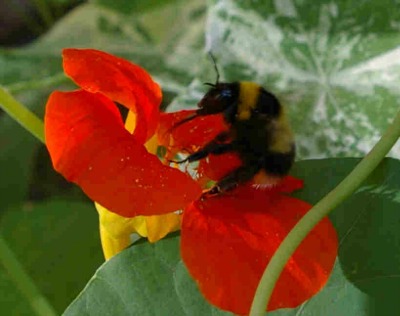
Various shades of nasturtium exist, including various shades of red. You could try the Alaska series for mixed nasturtiums that include shades of red as well as deep orange.
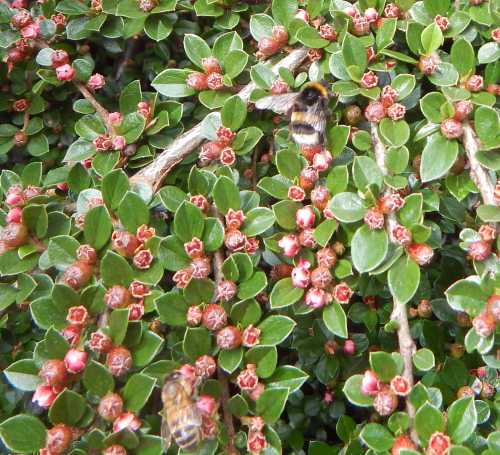
Inconspicuous the flowers of Cotoneaster horizontalis may be, but these small flowers are a magnet for many bees!
Others
Although I don't have an appropriate image, I'm aware that Alliums range in colours from whites through to purples and reds. For red varieties, try Allium amethystinum 'Red mohican'; Allium sphaerocephalon.
Are there any scientific research papers about color vision in bees?
Yes, here are a few of the research papers, publications and articles you can look up for yourself (I have not listed them in any particular order):
- Frisch, Karl von. 1956. Bees; their vision, chemical senses, and language. Ithaca, N.Y., Cornell University Press.
- Chittka, Lars & Brockmann, Axel. (2005). Perception Space—The Final Frontier. PLoS biology. 3. e137. 10.1371/journal.pbio.0030137.
- Chittka, L., & Wells, H. (2004). Color vision in bees: mechanisms, ecology and evolution. In: Prete, F.: Complex Worlds from simpler nervous systems; MIT Press, Boston pp. 165-191.
- Katzenberger, T.D., Lunau, K., Junker, R.R. (2013): Salience of multimodal flower cues controls bumblebee’s initial responses and learning behaviour. Behav. Ecol. Sociobiol. (in press).
- Papiorek, S., Rohde, K., Lunau, K. (2013): Bees` subtle colour preferences: How bees respond to small changes in pigment concentration. Naturwissenschaften 100: 633-643.
- Rohde, K., Papiorek, S., Lunau, K. (2013) Bumblebees (Bombus terrestris) and honeybees (Apis mellifera) prefer similar colours of higher spectral purity over trained colours. J. Comp. Physiol. A 199: 197-210.
- Lunau, K., Papiorek, S., Eltz, T., Sazima, M. (2011): Avoidance of achromatic colours by bees provides a private niche for hummingbirds. J. Exp. Biol. 214: 1607-1612.
- Menzel R. Achromatic vision in the honeybee at low light intensities. J. Comp. Physiol. A. 1981; 141: 389-393.
- Vereecken NJ, Dorchin A, Dafni A, Hötling S, Schulz S & Watts S, 2013. A pollinators’ eye view of a shelter mimicry system. Annals of Botany, doi:10.1093/aob/mct081.
- Vereecken NJ, Wilson CA, Hötling S, Schulz S, Banketov S & Mardulyn P, 2012. Pre-adaptations and the evolution of pollination by sexual deception: Cope’s rule of specialisation revisited. Proceedings of the Royal Society of London B 279(1748): 4786-4794.
More information about bees
- How Bees Carry Pollen On Different Parts Of Their Bodies Images illustrating different methods used by various species for pollen collecting and carrying.
- Bee Facts Quick snippets about the different types of bees, with links to further information, and facts about honey bees
- Why Do Bees Buzz? And how do they make that buzzing sound? Find out here!
- Where Do Bees Go In Winter And Do Bees Hibernate? About winter activity of honey bees, and overwintering or hibernation of bumble bees and solitary bees.
- How Long Do Bees Live? It depends on the type of bee, and the role in the colony. A look at the lifespans of honey bees, bumble bees and solitary bees.
If you found this page helpful or interesting, I'd really be grateful if you would share it with others - if not this page, perhaps another, such as Gardening For Bees.
Thank you so much :) .